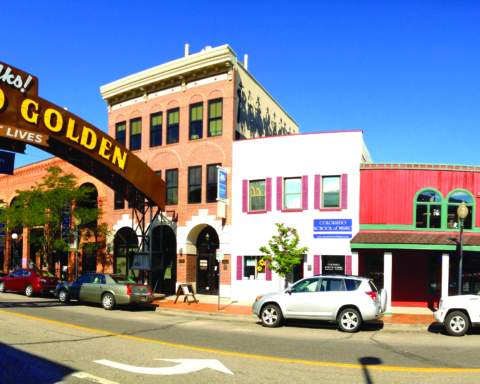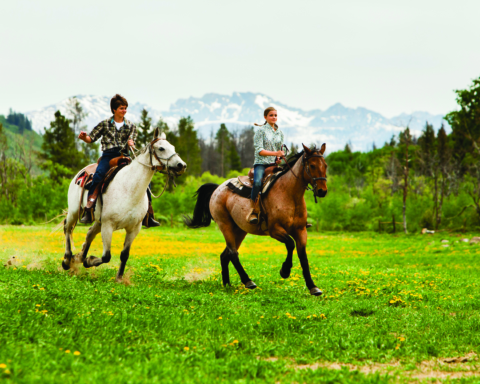BY REBECCA TREON
The Wild Animal Sanctuary offers a fresh start for animals.
Imagine spending your life in a small cage that is barely big enough to turn around in. Never seeing another of your kind, surviving as part of a roadside zoo, circus, or existing malnourished and underfed. Then imagine being rescued, nursed back to health, receiving regular feed- ings, and best of all, meeting animals of your own ilk. Space to roam and a clean, warm place to sleep. Welcome to the Wild Ani- mal Sanctuary, a fabulous slice of paradise located just 40 minutes from downtown Denver, and a welcome refuge for more than 450 rescued captive-born animals, primarily large carnivores like tigers, lions, bears and wolves.

The majority of these animals come from individuals who use the animals as attractions at roadside zoos or other profit-making schemes, or they’ve been kept by people desiring a large predator as a pet. In fact, each of the 50 states in the U.S. have different laws and regulations when it comes to keeping these animals – and some states have no laws at all. It’s believed that across the country, there are some 20,000 large carnivores kept outside of zoos – including 4,000 tigers in Texas alone (where these animals are allowed with a permit). Sadly, most of these animals are kept in deplorable conditions, languishing in too-small quarters, abused, abandoned, neglected, malnourished. When they are confiscated by law enforcement or animal welfare agencies, they find a ready home at the Wild Animal Sanctuary – and are allowed to ‘retire’ from being subject to the whims of unscrupulous people.

When the animals arrive at the sanctuary, their residency begins with a full health exam and extensive rehabilitation. Many arrive underweight and mal- nourished, and immediately undertake a program to augment their diet; others need dental work or have no muscle tone. Notably, though, a huge part of the animals’ rehab process is on the social and psychological side of things. So many of the animals that make their way to the sanctuary have never seen another of their breed, learned to bellow the sounds they make in the wild (i.e. lions who have never learned to roar), or don’t know how to be part of a social group like a pack or pride.

The animals are slowly introduced to the other animals, sometimes living in smaller quarters close to the main compound until they are fully rehabilitated and eventually ready to join other animals in large-acreage habitats. In fact, there are a pack of 12 rescue dogs that help younger animals learn how to be a part of social groups – biting, playing, and hierarchy. Once the animals have adjusted to their new home, most are put into large plots of land between five and 25 acres in size. Most of the animals rescued by the Wild Animal Sanctuary arrive underweight. Relying on donations from companies such as Wal-Mart, be- tween 48,000-50,000 pounds of food per week are provided to the animals, roughly half of which is meat, and half of which is fruit and vegetables.
The Wild Animal Sanctuary fills a void since there is no humane society of any kind for large animals. That means that when, for example, 25 Bolivian lions needed a home after the country banned animals in circuses, the Wild Animal Sanctuary got the call. They stepped up to provide a landing spot for the lions.

The sanctuary got its start when a young Pat Craig, who grew up on a farm near Boulder, visited a friend who worked at a zoo and got a behind-the-scenes tour he didn’t expect. What he saw shocked him: multiple animals in small cages were deemed as “extra” animals – no longer attracting visitors, they waited to be euthanized. Craig decided then and there he wanted to dedicate his life to saving these majestic animals, working to learn all he could. In 1980 the Wild Animal Sanctuary was started on a farm near Boulder, before moving to Lyons and finally to its current home, on 720 acres near Keenesburg, Colorado.
Almost by accident, Craig discovered an ideal way to view these majestic rescued animals, and at the same time educate people about the crisis of wild animals held in captivity. He found that if the animals were seen from above, they don’t have the flight or fight reaction to having an unfamiliar person or perceived threat in their living space. To that end, the Wild Animal Sanctuary constructed a raised walkway that allows guests to walk above the animals’ habitats and observe them. The 1.5-mile walkway enables visitors to see foxes, tigers, lions, wolves, bears, and more, all from above.

All the amazing work the Wild Animal Sanctuary performs would not be possible without the support of the public – it operates as a nonprofit and relies on donations from visitors. The sanctuary asks each visitor for a donation or to become an active supporter, whereby a regular donation is made and the member gets unlimited visits. The Wild Animal Sanctuary is well worth the trip for any visitor or resident of Denver. Given its proximity, there’s simply no reason not to go. The educational value of experiencing the important work of the Wild Animal Sanctuary is priceless. It appeals both as a way to observe and get close to these majestic wild animals, and also as an organization doing important work for disenfranchised animals. By giving a voice to these creatures, the sanctuary opens the hearts of young and old alike, showing them how animals live in the wild rather than in captivity. To be among them is both a gift and an unforgettable experience. One tip: don’t forget your binoculars.
Visit www.wildanimalsanctuary.org for more information








